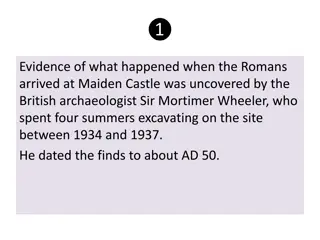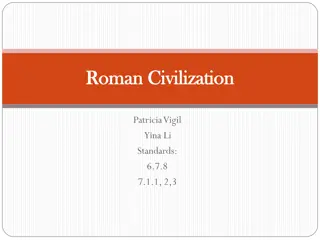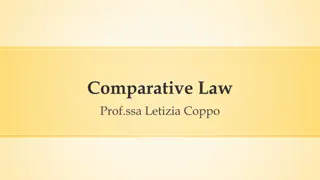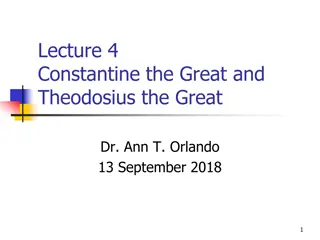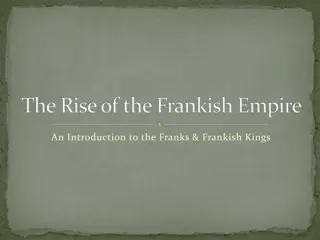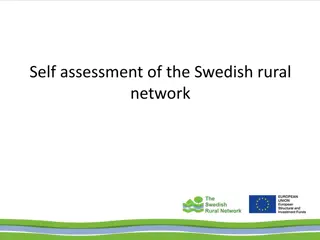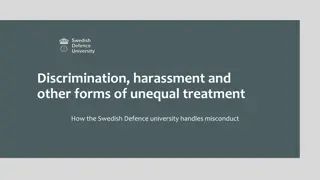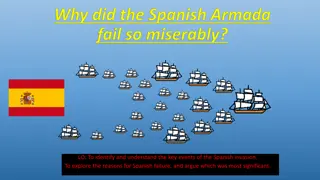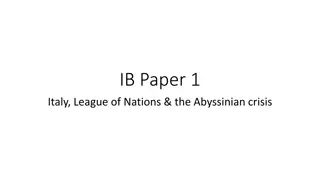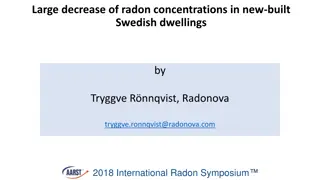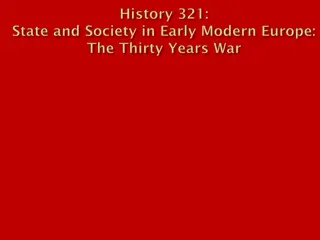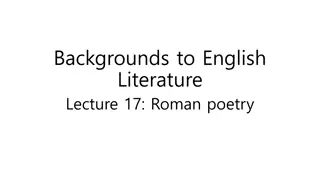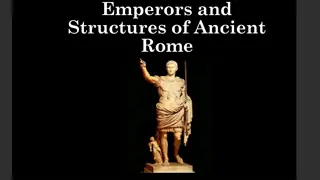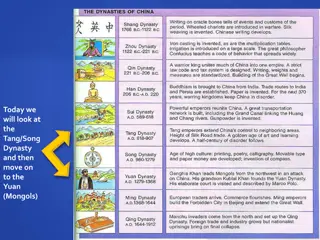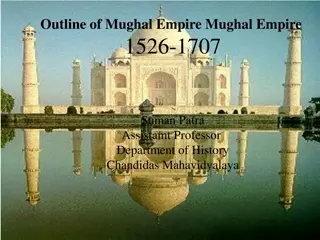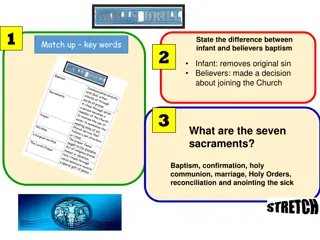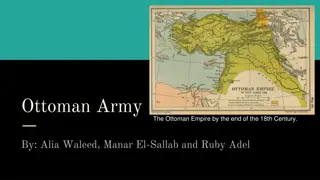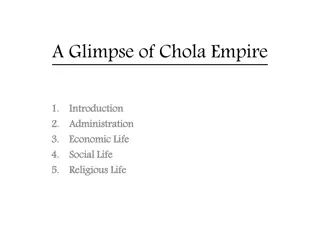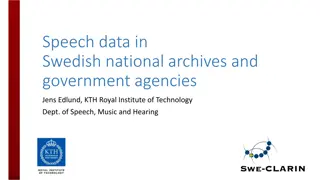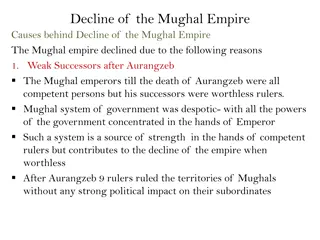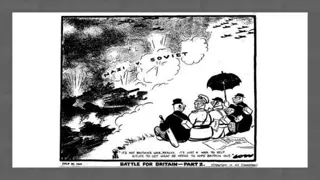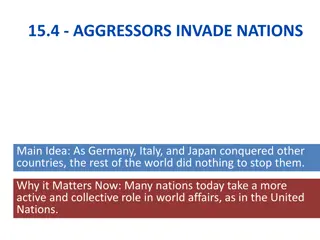The Swedish Invasion of the Holy Roman Empire: Motives, Success, and Challenges
Sweden's invasion of the Holy Roman Empire was initially driven by political motives rather than religious reasons. The Swedish success was attributed to their military expertise and alliances, but they faced challenges due to insufficient resources and reliance on German Protestant princes. Success was contingent on these alliances and the geopolitical situation of the time.
Download Presentation

Please find below an Image/Link to download the presentation.
The content on the website is provided AS IS for your information and personal use only. It may not be sold, licensed, or shared on other websites without obtaining consent from the author. Download presentation by click this link. If you encounter any issues during the download, it is possible that the publisher has removed the file from their server.
E N D
Presentation Transcript
1. Why did Sweden invade the Holy Roman Empire? 2. What explains Sweden s initial success? 3. What challenges did Sweden face?
1627: earliest consideration April 1630: Swedish Council of State accepted Gustavus claim about L beck, 1629 religious motive: to restore monasteries to Protestants? Gustavus did not intend this. Oxenstierna later admitted that religion was merely a pretext, while Gustavus said that if it had been the cause then he would have declared war on the pope (p. 462)
Security reduce the Emperor s power but no call for help from the Empire German liberties for the peace of Europe Satisfaction territorial gain: Stralsund, Pomerania (20 July 1630) Contentment of the army to make war at Germany s expense (p. 464) 1. 2. 3.
Sweden possessed the technical expertise and manpower for its invasion, but not the resources to sustain it. Gustavus was gambling his country s fortunes on the chance he could succeed where Christian of Denmark had failed and break south from his bridgehead (p. 459) alliance with France alliance with German states military conquest and assertion of power
Alliance with France Treaty of B rwalde (23 January 1631) France: 400,000 talers Sweden: 36,000 troops in HRE Sweden: no attack on Catholic League Sweden: religious freedom for Catholics a problem for France Treaty of Fontainebleau (31 May 1631) France: recognition of Maximilian I s electoral title France: defence of Bavaria against all enemies Bavaria: no support for France s enemies
Success depended entirely on the German Protestant princes who were now caught between the Swedish lion and the imperial eagle (p. 465) Gustavus to Georg Wilhelm of Brandenburg (brother-in-law): I don t want to be hear about neutrality. His grace must be my friend or foe (p. 465). Georg Wilhelm (1619-1640)
Leipzig Convention (1630) not a call for holy war not a confessional alliance a neutral block (40,000 troops) Ferdinand II s stubbornness: Edict of Restitution caution of Protestant princes initial support only from Christian Wilhelm: administrator of Magdeburg (1598-1631)
the battle for Magdeburg strategic importance for alliance with Protestants Colonel Falkenberg Gustavus invasion of Mecklenburg fall of Frankfurt on the Oder (13 April 1631) destruction of Magdeburg (20 May 1631) The disaster became a defining event in the war and did much to shape its subsequent interpretation as a benchmark for brutality (p. 470).
Ferdinand II cancelled Leipzig manifesto (14 May 1631) new Swedish allies Brandenburg (June 1631) Hessen-Kassel (27 July 1631) Saxony (12 September 1631) after unsuccessful negotiations with Empire after Tilly s invasion of Saxony (5 September) Johann Georg s objective: not religious war but pressure on the Emperor
Battle of Breitenfeld (17 September 1631) +7,000 dead Swedish losses: 2,100 men imperial prisoners Breitenfeld was the first major defeat of Catholic forces since the beginning of the war (p. 475).
more conquests 1631-32 Erfurt (2 October) W rzburg (15 October) Frankfurt am Main (17 November) Mainz (23 December) Lower Palatinate Mecklenburg
assertion of power allies Saxony invasion of Bohemia (1 November 1631) agreement with Empire? Hessen-Kassel British support: 6,000 troops Dutch Republic: limited subsidies (p. 480)
assertion of power Baltic Bridgehead Stralsund, Pomerania, Wismar in Mecklenburg archbishopric of Bremen (1631)
assertion of power strategic bases Erfurt, Magdeburg (1632) W rzburg, N rnberg (Franconia) Mainz (Rhineland) Frankfurt (lower Rhine) Augsburg (Swabia) relative religious freedom for Catholics
assertion of power finance (p. 482) French subsidies contributions from German states, cities German money not only paid the mercenaries who comprised between three- quarters and nine-tenths of the total army, but also covered 51 per cent of the 1 million riksdalers spent on the Swedish and Finnish contingent each year between 1630 and 1648 (p. 483).
assertion of power German collaborators to raise and command troops (p. 483) relatively small armies (5,000 troops) that were not entirely reliable minor Protestant princes (Wilhelm, Bernhard of Weimar) compensation: donations ecclesiastical properties at a price
assertion of power consequences for the imperial constitution conquered territories = Swedish fiefs allies: first allegiance to Swedish king feudal dues governors asserted Swedish overlordship (p. 486) the clear direction of Sweden s German policy was to usurp imperial authority and partition the Empire, restricting Habsburg influence to its hereditary lands (p. 487)
Imperial weakness Tilly s army: disorganized, crammed into Bavaria (p. 487) Tilly s death, 30 April 1632 Catholic refugees (in Cologne) For most people, regardless of confession, the spread of the war brought disease, hardship, and uncertainty (p. 488).
Imperial weakness unable to rescue Catholic Germany (p. 492) Charles of Lorraine: his army could not disrupt Swedes (October 1631) Spain: subsidies and more troops in Lower Palatinate France: invasion of Lorraine France: offer of protection: Mainz Ferdinand recalled Wallenstein, December 1631 unconstrained military and plenipotentiary powers (p. 492)
military developments, 1632 Imperial objective: secure Habsburg patrimony Catholic League army: Bavaria, Westphalia Swedish attack on Bavaria Battle of Bamberg (9 March 1632): Imperial victory Battle of the Lech (15 April 1632): Swedish victory Gustavus entry into Munich (17 May 1632)
military developments, 1632 Battles in other regions Steinau in Silesia (29 August, 4 September): Swedish victory Alte Veste near N rnberg (9 September): Imperial victory L tzen in Saxony (16 November): Swedish victory death of Gustavus Adolphus
Chancellor Axel Oxenstierna in charge League of Heilbronn, 1633 many German states France keep Sweden busy in Empire support for Dutch protect German Catholics control Lorraine
murder of Wallenstein (24 February 1634) reasons significance
Swedish mutiny orchestrated by officers donations continued Spanish intervention Duke of Feria (governor of Milan) ordered to march north relieved siege of Konstanz
Spanish Intervention Olivares plan restore Spanish strength along the Rhine obtain Imperial assistance against the Dutch send more troops to assist the Empire with Cardinal Infant Fernando (Ferdinand) cousin of Archduke Ferdinand (Ferdinand III, 1637-1657) the two Ferdinands
Spanish Intervention Battle of N rdlingen (6 September 1634): Imperial victory surrender of W rttemberg (November 1634) surrender of Heidelberg (November 1634) French efforts control of Philippsburg (September 1634) lost to Imperial forces (January 1635) proposal to exercise greater control of Heilbronn League: money, troops, restoration of Catholic worship
loss of allies to Empire Pirna talks, 1634-1635 Saxony Hessen-Darmstadt other Lutheran states




